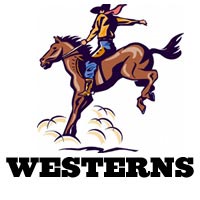Early Television Westerns Shows:
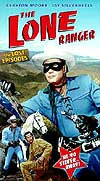 As B-westerns began to wane from theaters and reappear
on television (in the 50s), the genre's development took a major turn.Television
took its toll on western screen entertainment in the late 50s. The
B-pictures transferred themselves to the small screen throughout much
of the 50s and into the 60s. Westerns began dominating television
during the 1950s and 60s when the most popular shows were "Bonanza," "Wagon
Train," and "Rawhide." The Golden Age of the B Western,
with low-budget, B-picture horse operas, was coming to an end. As B-westerns began to wane from theaters and reappear
on television (in the 50s), the genre's development took a major turn.Television
took its toll on western screen entertainment in the late 50s. The
B-pictures transferred themselves to the small screen throughout much
of the 50s and into the 60s. Westerns began dominating television
during the 1950s and 60s when the most popular shows were "Bonanza," "Wagon
Train," and "Rawhide." The Golden Age of the B Western,
with low-budget, B-picture horse operas, was coming to an end.
Some of the early TV Westerns were derived from big-screen
features. The TV Western shows
resembled the second film features in theatre palaces in the 1930s
and 1940s, such as:
- The Cisco Kid (from 1950-1956), featuring Duncan
Renaldo as the heroic Cisco, and Leo Carrillo as his sidekick Pancho; Diablo
and Loco were their horses
- The Lone Ranger (from 1949-1957), starring Clayton
Moore as John Reid (the Lone Ranger) with his horse Silver, and Jay Silverheels
as Tonto, his faithful, full-blooded Mohawk sidekick
- The Roy Rogers Show (from 1951-1957), starring Roy
Rogers (King of the Cowboys) with Trigger, Dale Evans (Queen of the West)
with Buttermilk, Pat Brady as the sidekick and his jeep Nellybelle, and
Roy's dog Bullet
- Wild Bill Hickok (from 1951-1958), with Guy Madison
(as "Wild Bill") and his horse Buckshot, and Andy Devine as Deputy
Marshal Jingles P. Jones and his horse Joker
- Hopalong Cassidy (from 1951-1952), with William
Boyd as Bill "Hoppy" Cassidy, on his Bar 20 Ranch, with horse
Topper and sidekick Red Connors (Edgar Buchanan)
- Death Valley Days (from 1952-1975) with various
co-hosts including Stanley Andrews, Ronald Reagan, Dale Robertson, and Robert
Taylor
[Clayton Moore's first film with a mask - a full one
- was in the film The Ghost of Zorro (1949), a feature version
of the Republic Films serial. Moore's casting led to his subsequent
participation in the long-running TV series.] The black-masked man,
with a hearty "Hi-yo
Silver" and silver bullets, appeared in almost 170 episodes of The
Lone Ranger for television - and in two feature films. Because of
the popularity of the TV show and its "return to the thrilling
days of yesteryear," The Lone Ranger (1956), a full-length,
color feature film was released by Warner Bros, with Moore and Silverheels
reprising their TV roles. Their other feature film came out two years
later, The Lone Ranger and the Lost
City of Gold (1958). These popular TV programs were later joined
by such long-lasting TV series as: Gunsmoke, Rawhide, Bonanza, Wagon
Train, The Virginian, The Wild Wild West, Have Gun Will Travel,
and Wyatt
Earp. A short-lived ABC-TV series in the mid-60s, titled Shane with
David Carradine as the frontier gunfighter, was based on the classic
film Shane
(1953).
More Classic Westerns in a Resurgence:
 More
excellent adult westerns of the late 1940s and 1950s with classic character
studies include William Wellman's The Ox-Bow Incident
(1943) with Henry Fonda, and John Huston's adventure tale of greed The Treasure of the Sierra Madre (1948). These two pictures were
the only Western films to receive Academy Award nominations for Best Picture
in the 1940s. Director Henry King's The Gunfighter (1950) told
the story of a notorious, world-weary, quick-draw gunman named Jimmy Ringo (with a black mustache and black hat), played by Gregory Peck, often challenged, taunted and stalked by young men to gun-fight. More
excellent adult westerns of the late 1940s and 1950s with classic character
studies include William Wellman's The Ox-Bow Incident
(1943) with Henry Fonda, and John Huston's adventure tale of greed The Treasure of the Sierra Madre (1948). These two pictures were
the only Western films to receive Academy Award nominations for Best Picture
in the 1940s. Director Henry King's The Gunfighter (1950) told
the story of a notorious, world-weary, quick-draw gunman named Jimmy Ringo (with a black mustache and black hat), played by Gregory Peck, often challenged, taunted and stalked by young men to gun-fight.
One of the best was the landmark classic, dramatic morality
tale of an abandoned lawman, carefully filmed in "real-time." It
was director Fred Zinnemann's only western, High Noon (1952). The minimalist script written by Carl Foreman
(who was blacklisted during the 50s' anti-Communist hearings) was a political
allegory of 50s McCarthyism. In an Academy Award-winning performance, Gary
Cooper played the part of just-married (to Grace Kelly), aging small-town
Marshal Kane who heroically stood up to four vengeful, gunslinging killers
without assistance from the townsfolk that he had defended for his entire
career. This paralleled the historical incident of the early 50s' House Committee
on Un-American Activities' witch-hunt for Communists in Hollywood, and indicted
those who deserted their friends.
Another 'guilt-by-suspicion' allegorical film masking
as a criticism of the McCarthy era, Allan Dwan's psychological low-budget
western Silver Lode (1954), was set during a July 4th
celebration in a frontier town. It told about the tense hunt for the
wrongly-accused town sheriff Dan Ballard (John Payne) on his wedding
day to fiancee Rose Evans (Lizabeth Scott), by bad guy Ned McCarty
(Dan Duryea) and his deputies -- a clear reference to Sen. Joseph
McCarthy. The climactic confrontational scene in the church belltower
ended with antagonist McCarty's death and the eventual clearing of
Ballard's name.
 The
traditional, quintessential story of good vs. bad (civilization vs. lawlessness)
was also highlighted in George Stevens' gorgeously-filmed sole western, Shane (1953) with an extremely accurate portrayal of pioneer life.
Actor Alan Ladd portrayed a mysterious, gunslinger/drifter, the archetypal
Western hero, who joined the struggle of the civilizing community of homesteaders
against the cattlemen. In the end, the title character - forever branded as
a killer, rode off toward the mountains after accomplishing his task of bringing
normalcy back to the area. The
traditional, quintessential story of good vs. bad (civilization vs. lawlessness)
was also highlighted in George Stevens' gorgeously-filmed sole western, Shane (1953) with an extremely accurate portrayal of pioneer life.
Actor Alan Ladd portrayed a mysterious, gunslinger/drifter, the archetypal
Western hero, who joined the struggle of the civilizing community of homesteaders
against the cattlemen. In the end, the title character - forever branded as
a killer, rode off toward the mountains after accomplishing his task of bringing
normalcy back to the area.
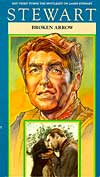 Hollywood
would often mix fact with fiction and prejudicial bias in its westerns. Delmer
Daves' revisionist western Broken Arrow (1950), however, was considered
the first Hollywood picture to seriously take the side of the Indians
(Native-Americans) and emphasize peaceful co-existence, with a sympathetic
portrayal of Apache chief Cochise (by white actor Jeff Chandler with a Best
Supporting Actor nomination - it was his first of three films as the Indian
chief), and Debra Paget as Indian maiden Sonseeahray. This film also marked
the beginning of James Stewart's post-war work as a western character. [Broken
Arrow became a TV series in the mid-50s.] Pony Express (1953) was
a quasi-historical account of the extension of the mail route with western
legends Buffalo Bill Cody (Charlton Heston) and Wild Bill Hickok (Forrest
Tucker). Another Charlton Heston western, titled Arrowhead (1953) expressed
a biased view of Indians and starred Jack Palance as an Apache chief. Hollywood
would often mix fact with fiction and prejudicial bias in its westerns. Delmer
Daves' revisionist western Broken Arrow (1950), however, was considered
the first Hollywood picture to seriously take the side of the Indians
(Native-Americans) and emphasize peaceful co-existence, with a sympathetic
portrayal of Apache chief Cochise (by white actor Jeff Chandler with a Best
Supporting Actor nomination - it was his first of three films as the Indian
chief), and Debra Paget as Indian maiden Sonseeahray. This film also marked
the beginning of James Stewart's post-war work as a western character. [Broken
Arrow became a TV series in the mid-50s.] Pony Express (1953) was
a quasi-historical account of the extension of the mail route with western
legends Buffalo Bill Cody (Charlton Heston) and Wild Bill Hickok (Forrest
Tucker). Another Charlton Heston western, titled Arrowhead (1953) expressed
a biased view of Indians and starred Jack Palance as an Apache chief.
Robert Enrico's Oscar-winning, dialogue-less, 28-minute short La Riviere du Hibou (1962) was a French adaptation based on Ambrose
Bierce's 1891 story 'An Occurrence at Owl Creek Bridge'. The Civil War western
story with a twist-ending, about an innocent man who seemed to escape from
death by a hangman's noose, became well-known when shown to a large American
audience as an edited and narrated episode (the final episode!) of Rod Serling's The Twilight Zone television show in 1964.
Wide-Screen Westerns:
To combat the decline of the film western, wide-screen frontier
epics in the 50s and early 60s appeared, emphasizing the western frontier
and expansion. Representative films included:
- Howard Hawks' second western The Big Sky (1952),
a sprawling 1830s keelboat expedition adventure with Kentucky frontiersmen
(Kirk Douglas and Dewey Martin) on the Missouri River
- director John Farrow's stereoscopic, partially 3-D Hondo
(1953) starring John Wayne and Geraldine Page (in her screen debut)
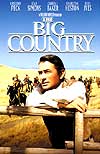 director
Robert Aldrich's wide-screen Superscope Vera Cruz (1954) teaming
Burt Lancaster and Gary Cooper during the Mexican Revolution of
1866 director
Robert Aldrich's wide-screen Superscope Vera Cruz (1954) teaming
Burt Lancaster and Gary Cooper during the Mexican Revolution of
1866- director Edward Dmytryk's Deluxcolor Broken Lance (1954),
a western King Lear with Spencer Tracy, that won a Best Original
Story Academy Award, and a Best Supporting Actress nomination for Katy Jurado
- even a conventional drama such as
John Sturges' Bad Day at Black Rock (1955) used a classic Western setting and plot-line and updated them to modern-day
circumstances, bringing additional suspense to the story with the use of
widescreen. Spencer Tracy as a one-armed, lone passenger dressed in black
arrives in a deserted western town by train to learn about a town's dark
secret
- William Wyler's big-budget, star-studded and sprawling The Big Country (1958) with Gregory Peck as an Eastern sea captain
caught in the midst of a Western ranching and water rights feud between
his fiancee's father (Charles Bickford) and their neighbor (Burl Ives)
- John Wayne as Davy Crockett in the lengthy action-epic The Alamo (1960), Wayne's directorial debut film (although some of
it was directed by John Ford) - an effort that failed at the box-office
although it was nominated for six Academy Awards (due to insistent and somewhat
annoying Oscar campaigning); the film was remade over 40 years later as The Alamo (2004), with Billy Bob Thornton filling in for the Duke's
musket-wielding Davy Crockett
- the widescreen Cinerama film How The West Was Won (1963),
a tremendous, star-studded three-generation story of pioneers
John Sturges' Two Western Blockbusters:
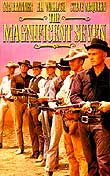 Sturges' Gunfight at the OK Corral (1957) told the story of Marshal Wyatt Earp
(Burt Lancaster) in Tombstone, Arizona feuding with the Clantons and their
hired guns -- with its inevitable showdown in 1888, aided by the gunfire of
rum-soaked Dr. John 'Doc' Holliday (Kirk Douglas). Sturges' Gunfight at the OK Corral (1957) told the story of Marshal Wyatt Earp
(Burt Lancaster) in Tombstone, Arizona feuding with the Clantons and their
hired guns -- with its inevitable showdown in 1888, aided by the gunfire of
rum-soaked Dr. John 'Doc' Holliday (Kirk Douglas).
His next popular film, The Magnificent Seven (1960) rewrote
a Japanese classic about Samurai warrior-swordsmen that defended a
14th century village (Akira Kurosawa's The
Seven Samurai (1954, Jp.)). This updated 'remake,' featuring a
memorable, Oscar-nominated score by Elmer Bernstein, starred these
seven gun-slinging American outlaws who defended Mexican peasants against
bandit leader Eli Wallach:
- Yul Brynner
- Steve McQueen
- knife-thrower James Coburn
- wood-cutter Charles Bronson
- Robert Vaughn
- Horst Bulchholz
- Brad Dexter
[It was followed by three inferior sequels: Return of the
Seven (1966), Guns of the Magnificent Seven (1969), and The
Magnificent Seven Ride! (1972).] One of the most exciting action-adventure
westerns of all time was writer/director Richard Brooks' big-budget ensemble
western The Professionals (1966), with Lee Marvin as the leader of
a group of mercenaries (including explosives expert Burt Lancaster, horsemen
Robert Ryan, and tracker/longbow expert Woody Strode) into Mexico on a dangerous
mission to rescue a wealthy industrialist's ransomed wife (Claudia Cardinale)
from Mexican rebel kidnappers (headed by Jack Palance).
John Wayne: The Archetypal Western Hero (or Anti-Hero)
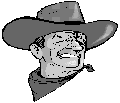 John
Wayne, towering and dominant, remains the most popular and durable of the
major western film stars of the modern era. [Other western stars also included
Henry Fonda, Clint Eastwood, Randolph Scott, James Stewart, Joel McCrea, and
Gary Cooper.] In Wayne's many films, he embodied the great American hero and
forever closely identified with the genre. A short summary of his films shows
how deeply ingrained he was within the western film. John
Wayne, towering and dominant, remains the most popular and durable of the
major western film stars of the modern era. [Other western stars also included
Henry Fonda, Clint Eastwood, Randolph Scott, James Stewart, Joel McCrea, and
Gary Cooper.] In Wayne's many films, he embodied the great American hero and
forever closely identified with the genre. A short summary of his films shows
how deeply ingrained he was within the western film.
Nine years after his first western The Big Trail (1930),
Wayne further developed his western persona in Stagecoach (1939), and then performed in a series of action-packed
WWII pictures in the early to mid-40s. He reappeared in Howard Hawks' epic
of a mutinous cattle drive Red River (1948), and in John Ford's cavalry trilogy (see above).
Wayne also starred in his best Western (anti-hero) role in probably the best
Hollywood Western ever made - John Ford's The Searchers (1956), one of the few westerns which has consistently
won praise as a work of art. [It has inspired other directors and their non-Western
films, from Taxi Driver (1976) to Star Wars (1977).] The VistaVision film, shot in Monument Valley, portrayed Wayne as a racist, hate-driven, and
lonely outsider relentlessly and obsessively searching over a period of years
for his Comanche-kidnapped niece (played by a young Natalie Wood).
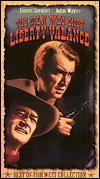 John
Ford memorably united two major stars of the genre in his last great
film, the excellent adult western The
Man Who Shot Liberty Valance (1962),
John Wayne and James Stewart -- and also Lee Marvin as 'Liberty Valance'
(allegedly shot by Stewart). Its byword was "When the Legend
Becomes Fact, Print the Legend." In the 60's, Wayne also acted
in Andrew McLaglen's comedy western McLintock! (1963) (a battle-of-the-sexes
film with Maureen O'Hara), Burt Kennedy's The War Wagon (1967) with
Kirk Douglas, and Henry Hathaway's The Sons of Katie Elder (1965) with
Wayne's second co-starring role with Dean Martin. John
Ford memorably united two major stars of the genre in his last great
film, the excellent adult western The
Man Who Shot Liberty Valance (1962),
John Wayne and James Stewart -- and also Lee Marvin as 'Liberty Valance'
(allegedly shot by Stewart). Its byword was "When the Legend
Becomes Fact, Print the Legend." In the 60's, Wayne also acted
in Andrew McLaglen's comedy western McLintock! (1963) (a battle-of-the-sexes
film with Maureen O'Hara), Burt Kennedy's The War Wagon (1967) with
Kirk Douglas, and Henry Hathaway's The Sons of Katie Elder (1965) with
Wayne's second co-starring role with Dean Martin.
In later years, Wayne's character aged and matured in such
"autumnal" films as Howard Hawks' El Dorado (1967) (a remake of Hawks'
own Rio Bravo (1959) again with Wayne), Henry Hathaway's True Grit
(1969) in which he finally won a Best Actor Oscar as Rooster Cogburn,
a boozy marshal engaged in a track-down, and in its sequel, Rooster Cogburn
(1975), with Wayne in an African Queen-like role opposite Katharine
Hepburn. Two of Wayne's last-day films were Mark Rydell's The Cowboys (1972) and Don Siegel's elegiac The Shootist (1976), in which Wayne (in his
final film) played a famous gunfighter seeking peace while dying of cancer. |
